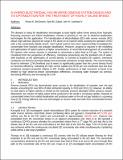| dc.contributor.author | McGovern, Ronan Killian | |
| dc.contributor.author | Zubair, Syed M. | |
| dc.contributor.author | Lienhard, John H | |
| dc.date.accessioned | 2014-12-04T20:01:18Z | |
| dc.date.available | 2014-12-04T20:01:18Z | |
| dc.date.issued | 2014-04 | |
| dc.identifier.issn | 1947-7953 | |
| dc.identifier.issn | 2051-6452 | |
| dc.identifier.uri | http://hdl.handle.net/1721.1/92032 | |
| dc.description.abstract | The demand is rising for desalination technologies to treat highly saline brines arising from hydraulic fracturing processes and inland desalination. Interest is growing in the use of electrical desalination technologies for this application. The hybridization of electrodialysis (ED) with reverse osmosis (RO) allows high salinities (beyond the range of RO alone) to be reached while avoiding the operation of ED with a low conductivity diluate stream. Such hybrid systems have been experimentally investigated for concentrates from brackish and seawater desalination. However, progress is required in the modelling and optimization of hybrid systems at higher concentrations. A novel hybrid arrangement of counterflow ED systems with reverse osmosis is presented to concentrate a saline feed at 120 ppt. The system is considered from the perspective of efficiency, membrane productivity and the levelised cost of water, with emphasis on the optimisation of current density. In contrast to brackish ED systems, membrane resistances are found to dominate diluate and concentrate resistances at high salinity. The current density found to minimise LCW (levelised cost of water) is significantly greater than the current density found to maximise efficiency, indicating the high current capital cost of ED per unit membrane area and poor membrane transport properties relative to RO. Finally, performance at high recoveries is found to be limited by high stream-to-stream concentration differences, increasing water transport via osmosis, decreasing efficiency and increasing the LCW. | en_US |
| dc.description.sponsorship | Fulbright Program | en_US |
| dc.description.sponsorship | Martin Family Society of Fellows for Sustainability | en_US |
| dc.description.sponsorship | International Desalination Association (Channabasappa Memorial Scholarship) | en_US |
| dc.language.iso | en_US | |
| dc.publisher | International Desalination Association | en_US |
| dc.relation.isversionof | http://dx.doi.org/10.1179/2051645214Y.0000000016 | en_US |
| dc.rights | Creative Commons Attribution-Noncommercial-Share Alike | en_US |
| dc.rights.uri | http://creativecommons.org/licenses/by-nc-sa/4.0/ | en_US |
| dc.source | Prof. Lienhard via Angie Locknar | en_US |
| dc.title | Hybrid electrodialysis reverse osmosis system design and its optimization for treatment of highly saline brines | en_US |
| dc.type | Article | en_US |
| dc.identifier.citation | McGovern, R. K., S. M. Zubair, and J. H. Lienhard V. “Hybrid Electrodialysis Reverse Osmosis System Design and Its Optimization for Treatment of Highly Saline Brines.” IDA Journal of Desalination and Water Reuse 6, no. 1 (April 2014): 15–23. | en_US |
| dc.contributor.department | Massachusetts Institute of Technology. Department of Mechanical Engineering | en_US |
| dc.contributor.department | Abdul Latif Jameel Poverty Action Lab (Massachusetts Institute of Technology) | en_US |
| dc.contributor.approver | Lienhard, John H. | en_US |
| dc.contributor.mitauthor | McGovern, Ronan Killian | en_US |
| dc.contributor.mitauthor | Zubair, Syed M. | en_US |
| dc.contributor.mitauthor | Lienhard, John H. | en_US |
| dc.relation.journal | IDA Journal of Desalination and Water Reuse | en_US |
| dc.eprint.version | Original manuscript | en_US |
| dc.type.uri | http://purl.org/eprint/type/JournalArticle | en_US |
| eprint.status | http://purl.org/eprint/status/NonPeerReviewed | en_US |
| dspace.orderedauthors | McGovern, R. K.; Zubair, S. M.; Lienhard V, J. H. | en_US |
| dc.identifier.orcid | https://orcid.org/0000-0002-7086-5005 | |
| dc.identifier.orcid | https://orcid.org/0000-0002-2901-0638 | |
| dc.identifier.orcid | https://orcid.org/0000-0002-3808-8824 | |
| mit.license | OPEN_ACCESS_POLICY | en_US |
| mit.metadata.status | Complete | |
